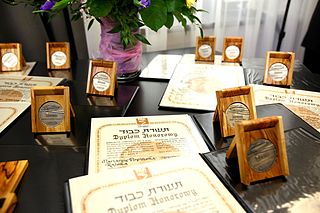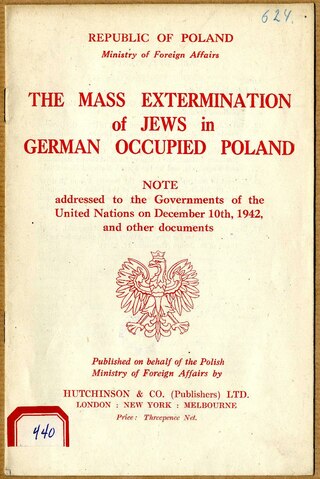Related Research Articles

Żegota was the Polish Council to Aid Jews with the Government Delegation for Poland, an underground Polish resistance organization, and part of the Polish Underground State, active 1942–45 in German-occupied Poland. Żegota was the successor institution to the Provisional Committee to Aid Jews and was established specifically to save Jews. Poland was the only country in German-occupied Europe where such a government-established and -supported underground organization existed.
Following the establishment of the Second Polish Republic after World War I and during the interwar period, the number of Jews in the country grew rapidly. According to the Polish national census of 1921, there were 2,845,364 Jews living in the Second Polish Republic; by late 1938 that number had grown by over 16 percent, to approximately 3,310,000, mainly through migration from Ukraine and the Soviet Russia. The average rate of permanent settlement was about 30,000 per annum. At the same time, every year around 100,000 Jews were passing through Poland in unofficial emigration overseas. Between the end of the Polish–Soviet War of 1919 and late 1938, the Jewish population of the Republic grew by nearly half a million, or over 464,000 persons. Jews preferred to live in the relatively-tolerant Poland rather than in the Soviet Union and continued to integrate, marry into Polish Gentile families, to bring them into their community through marriage, feel Polish and form an important part of Polish society. Between 1933 and 1938, around 25,000 German Jews fled Nazi Germany to sanctuary in Poland.

Henryk Iwański (1902-1978), nom de guerre Bystry, was a member of the Polish resistance during World War II. He is known for leading one of the most daring actions of the Armia Krajowa in support of the Warsaw Ghetto Uprising, however later research cast doubts on the veracity of his claims. For his assistance to the Polish Jews Iwański was bestowed the title of the Righteous Among the Nations by Yad Vashem in Jerusalem in 1964.


Szmalcownik ; in English, also sometimes spelled shmaltsovnik) is a pejorative Polish slang expression that originated during the Holocaust in Poland in World War II and refers to a person who blackmailed Jews who were in hiding, or who blackmailed Poles who aided Jews, during the German occupation. By stripping Jews of their financial resources, blackmailers added substantially to the danger that Jews and their rescuers faced and increased their chances of being caught and killed.
Anti-Jewish violence in Poland from 1944 to 1946 preceded and followed the end of World War II in Europe and influenced the postwar history of the Jews as well as Polish-Jewish relations. It occurred amid a period of violence and anarchy across the country, caused by lawlessness and anti-communist resistance against the Soviet-backed communist takeover of Poland. The estimated number of Jewish victims varies and ranges up to 2,000. In 2021, Julian Kwiek published the first scientific register of incidents and victims of anti-Jewish violence in Poland in 1944–1947, according to his calculations, the number of victims was at least 1,074 to 1,121. Jews constituted between 2% and 3% of the total number of victims of postwar violence in the country, including the Polish Jews who managed to escape the Holocaust on territories of Poland annexed by the Soviet Union, and returned after the border changes imposed by the Allies at the Yalta Conference. The incidents ranged from individual attacks to pogroms.

The citizens of Poland have the highest count of individuals who have been recognized by Yad Vashem as the Polish Righteous Among the Nations, for saving Jews from extermination during the Holocaust in World War II. There are 7,177 Polish men and women conferred with the honor, over a quarter of the 27,921 recognized by Yad Vashem in total. The list of Righteous Among the Nations is not comprehensive and it is estimated that hundreds of thousands of Poles concealed and aided tens of thousands of their Polish-Jewish neighbors. Many of these initiatives were carried out by individuals, but there also existed organized networks of Polish resistance which were dedicated to aiding Jews – most notably, the Żegota organization.

Neighbors: The Destruction of the Jewish Community in Jedwabne, Poland is a book published in 2000 written by Princeton University historian Jan T. Gross exploring the July 1941 Jedwabne massacre committed against Polish Jews by their non-Jewish neighbors in the village of Jedwabne in Nazi-occupied Poland.

Irena Adamowicz, was a Polish-born scout leader and a resistance member during World War II. She was a courier for the underground Home Army. In 1985, Adamowicz was posthumously bestowed the title of the Righteous Among the Nations by Yad Vashem in Jerusalem for her activities involving providing information to a number of Jewish ghettos in occupied Poland.

Polish Jews were the primary victims of the Nazi Germany-organized Holocaust in Poland. Throughout the German occupation of Poland, Jews were rescued from the Holocaust by Polish people, at risk to their lives and the lives of their families. According to Yad Vashem, Israel's official memorial to the victims of the Holocaust, Poles were, by nationality, the most numerous persons identified as rescuing Jews during the Holocaust. By January 2022, 7,232 people in Poland have been recognized by the State of Israel as Righteous among the Nations.

Ignacy Izaak Schwarzbart was a prominent Polish Zionist, and one of Jewish representatives on the Polish National Council of the Polish Government-in-Exile during the Second World War, along with Szmul Zygielbojm.

The Lutsk Ghetto was a Nazi ghetto established in 1941 by the SS in Lutsk, Western Ukraine, during World War II. In the interwar period, the city was known as Łuck and was part of the Wołyń Voivodeship (1921–1939) in the Second Polish Republic.

The Tarnopol Ghetto was a Jewish World War II ghetto established in 1941 by the Schutzstaffel (SS) in the prewar Polish city of Tarnopol.
During the German occupation of Poland, citizens of all its major ethnic groups collaborated with the Germans. Estimates of the number of collaborators vary. Collaboration in Poland was less institutionalized than in some other countries and has been described as marginal, a point of pride with the Polish people. During and after the war, the Polish government in exile and the Polish resistance movement punished collaborators and sentenced thousands of them to death.

Hunt for the Jews: Betrayal and Murder in German-Occupied Poland is a 2013 book about the Holocaust in Poland by Jan Grabowski. The 2013 English edition followed a 2011 Polish-language edition and was in turn followed by a 2016 Hebrew edition.

The Mass Extermination of Jews in German Occupied Poland was a brochure published by the Polish government-in-exile in 1943 to disseminate the text of Raczyński's Note of 10 December 1942. It was the first official information to the Western general public about the Holocaust in German-occupied Poland.

The Polish Underground and the Jews, 1939–1945 is a book by American historian Joshua D. Zimmerman, published in 2015 by Cambridge University Press, discussing relations between Poland's Jewish population and the Polish resistance in World War II. Zimmerman argues that polarized narratives, one picturing the Polish underground as anti-Semitic and murderous toward Jews and the other hand as heroically rescuing them, are oversimplified; in fact, different segments and members of the Home Army behaved in diverse ways. The book has received mostly-positive reviews for its evenhanded treatment of a contentious subject matter.

Contested Memories: Poles and Jews During the Holocaust and Its Aftermath is a 2003 book discussing the Holocaust in Poland. Contributors include Zvi Gitelman, Nechama Tec, Israel Gutman, Henry Abramson, Samuel Kassow, Dariusz Stola, David Engel, Stanisław Krajewski, Feliks Tych, Gunnar S. Paulsson, and Michael C. Steinlauf. It was edited by Joshua D. Zimmerman.

Don Arrigo Beccari, was an Italian priest and teacher. He was recognized as a Righteous Among the Nations for his rescue operation. During WWII he rescued about 120 Jews, most of them children from Villa Emma along with the town’s doctor Giuseppe Moreali.
This is a select bibliography of English language books and journal articles about the history of Poland during World War II. A brief selection of English translations of primary sources is included. Book entries have references to journal articles and reviews about them when helpful. Additional bibliographies can be found in many of the book-length works listed below; see Further Reading for several book and chapter-length bibliographies. The External Links section contains entries for publicly available select bibliographies from universities. This bibliography specifically excludes non-history related works and self-published books.
References
- ↑ "Joshua D. Zimmerman". Yeshiva University.
- ↑ "Dr. Joshua Zimmerman". United States Holocaust Memorial Museum.
- 1 2 "Contested Memories". Rutgers University Press. Archived from the original on 3 April 2020.
- ↑ "Curriculum Vitae" (PDF). Yeshiva University.
- ↑ Rodogno, Davide (January 2008). "Review: Joshua D. Zimmerman, ed., The Jews of Italy under Fascist and Nazi Rule, 1922—1945, Cambridge University Press: Cambridge, 2005; 396 pp.; 0521841011, £25 (hbk)". European History Quarterly. 38 (1): 195–197. doi:10.1177/02656914080380010446. ISSN 0265-6914. S2CID 144261958.
- ↑ Polonsky, Antony (2015). "The Complex Story of the Armia Krajowa: Review of Joshua Zimmerman, The Polish Underground and the Jews, 1939-1945". Yad Vashem Studies. 43 (2).
- ↑ Theodore R. Weeks, review in The Polish Review , vol. 63, no. 1, 2018, pp. 107–9; quotation, p. 108.